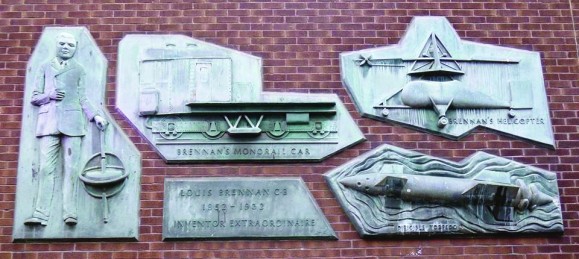A renowned Irish inventor is honored in London.
Louis Philip Brennan was born on Main Street, Castlebar, Co. Mayo, on 28 January 1852. He was the tenth child of Thomas Brennan, a hardware merchant in the town.
Following the death of at least five of Louis’s older siblings as small children during the Irish Famine Years (1845-1847), the Brennan family emigrated to start a new life in the gold rush boomtown of Melbourne, Australia.
Louis Brennan started his working life as a watchmaker in Australia and went on to become an Irish-Australian mechanical engineer and inventor of Brennan’s torpedo, the world’s first practical guided missile, and the gyroscopic monorail.
Sir Winston Churchill once remarked about Brennan’s monorail, “Sir, your invention promises to revolutionize the railway systems of the world.”
Churchill would do his very best to ensure that Brennan’s monorail would become the most sought after transport system of the 20th century. He did not succeed, but nonetheless, with a torpedo and a helicopter also under his belt, Brennan may be the most remarkable inventor ever born in Ireland.
At the tender age of 22, Brennan invented for coastal defense a torpedo which was propelled by counter-rotating screws driven by the unwinding of two fine steel wires from internal drums and steered by the differential action of the two wires which were wound onto drums on shore or on shipboard by a 28 horsepower steam engine. It became known as “Brennan’s Torpedo.”
Soon after, Brennan moved to England and became manager of the Government Torpedo Manufacturing Plant in Kent, which manufactured his torpedo, from 1880 to 1896.
He took up employment with the Ministry of Munitions from 1910 until 1918, moving to the Royal Aircraft factory at Farnborough, where he invented a type of helicopter. However, the withdrawal of funds prevented the invention from being made a commercial proposition. At the time of his death, Brennan had at least 38 items patented in London
He was knocked down by a car on December 26, 1931, while on vacation in Montreux, Switzerland, and died on January 17, 1932 as a result of the injuries he received.
Brennan was buried in an unmarked grave, plot No. 2454, St. Mary’s Cemetery, Harrow Road, London on January 26, 1932.
In 2012, following a public meeting held in the Travellers Friend Hotel a local committee was set up to arrange for a suitable memorial to this famous Castlebar-born inventor.
This small and dedicated group, consisting of historians Ernie Sweeney, Michael Baynes, Michael Feeney, and Councillor Ger. Deere and myself, have worked tirelessly for the past two years to ensure this project would come to fruition.
Now, thanks to members of the Irish diaspora in England, especially retired Manchester businessman John Kennedy, Londoners Andy Rogers, John Basquill, and Kieran Mc Cormack, and with additional support from Castlebar Town Council, Louis Brennan will be given the recognition he richly deserves.
On March 11, 2014, a newly fashioned headstone will officially mark the final resting place of Louis Brennan.
The ceremony will be performed by Taoiseach Enda Kenny, who will be accompanied by Noreen Heston, Mayor of Castlebar. Descendants of Louis Brennan from the U.S. will join with members of the organizing committee from Castlebar and members of Mayo Associations in the U.K. for this historic event.
In addition to the headstone unveiling, a memorial service will be conducted by Monsignor Canon Thomas Egan, Chief Administrator at St. Mary’s Cemetery and also a Castlebar native. A plaque commemorating Brennan’s work will also be unveiled.
Brennan’s Torpedo


Leave a Reply